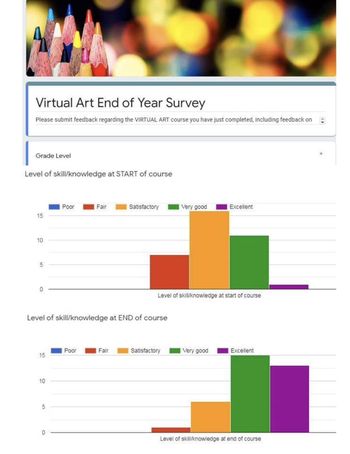Course Evaluation Surveys are a mainstay of higher education. While not as common in middle and high school, they can still provide valuable information. What is a course Evaluation Survey exactly? A course evaluation survey gathers feedback from students who have taken a course to evaluate the course’s and the instructor’s effectiveness.
Why have a course evaluation survey? At the end of the year, the focus is often on crossing the finish line and meeting everything on our end-of-the-year checklists. It’s a particularly busy time of the year. So why prioritize a course evaluation survey? Ultimately, it’s about improving. We need feedback to improve ourselves as teachers and our curriculums. Art teacher Phoebe Plaisted, an advoke for course evaluations, shares, “The data gleaned from student self-reporting surveys has been really useful as an educator and in demonstrating student learning in a quantitative way.”
Some teachers may shy away from course evaluation forms for fear that students aren’t mature enough to assess an adult fairly and honestly. Why do it then? One teacher commented, “It was great for getting feedback and new ideas I am incorporating into my class this semester.” A course evaluation can also give students time to reflect on their efforts and work habits, not just the teacher’s. While students might take the opportunity to vent their frustrations, it’s important that they feel valued and heard. Our job is to sift the information into meaningful content and actionable steps. Art teacher Phoebe Plaisted reports, “Students are generally very respectful and give honest, thoughtful input.”
What is typical to have on a class evaluation form? Question topics can include:
- Teaching Methods and Strategies
Examples might include: Were the instructor’s teaching methods effective? Did you get the feedback on assignments and grades in a timely manner? How successful was the course instructor in managing time effectively and keeping the course on track? How prepared was the instructor for each class and the course in general? - Teacher Personal Connection and Encouragement
Example: Did the instructor treat you and your work with respect? Did the instructor challenge you to develop your abilities? - Course Materials
Example: Did the instructional materials (e.g., slide shows, handouts, demonstrations, discussion, etc.) increase the student’s knowledge and skills in the subject matter? - Student Engagement and Involvement: What was your subject knowledge level at the start of the course and the end? How many hours did you spend on assignments and studying outside of lectures? Did you use your class time effectively to complete projects?
Student Self-Evaluation Questions - Questions Specific to Arts Courses
General/overall survey questions
What format? You can use good old-fashioned paper and pencil. Art teacher Morgan Good gives students a blank star review, like what you find on Yelp Reviews. Students color in the stars and write a comment. Good says the answers run from “silly and sweet” to “genuinely helpful.” Or you can take advantage of technology. Google Forms is a popular option, providing the data collected in a nice visual format. Examples from art teacher Phoebe Plaisted’s course evaluations are shown below.


Surveys can collect data in many different ways. You can make a statement and ask the responder to answer with a 1-5 range. For example, the survey may state, “I feel lessons were challenging.” The student can select 1 for not very challenging, 5 for very challenging, or any number that best describes their experiences. Multiple-choice questions are another way of collecting information. For example, “What was your favorite project?” then list all the projects you did with that class for them to select. Open-ended questions are another option. Such as, “What did you like most about the course?“
It is good to do course evaluations anonymously, and after grades close so students feel they can be honest in their responses. This provides meaningful activity for the last day when rooms are packed up. The information can then be waiting for you to review when you start planning for the next school year, which will come around all too quickly!
You might want to check out David Hill’s Google form here (You will be asked to make a copy).




